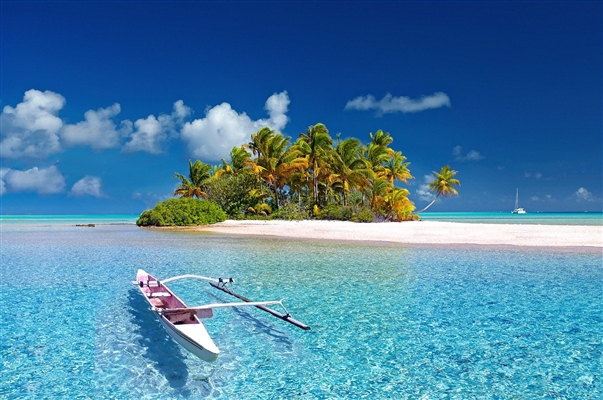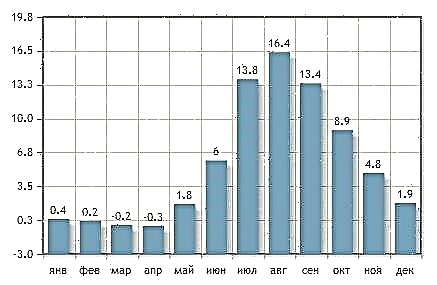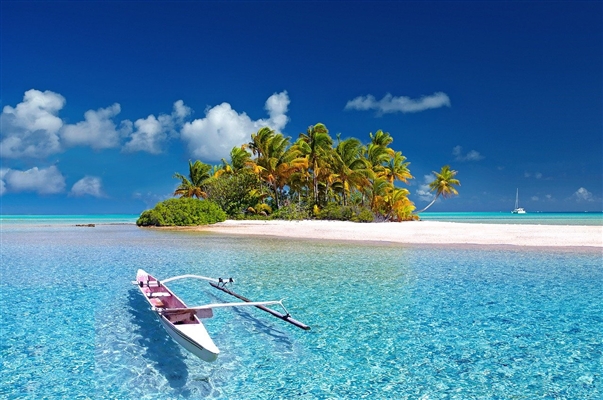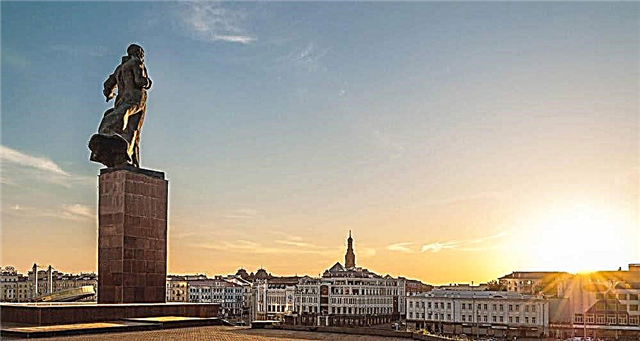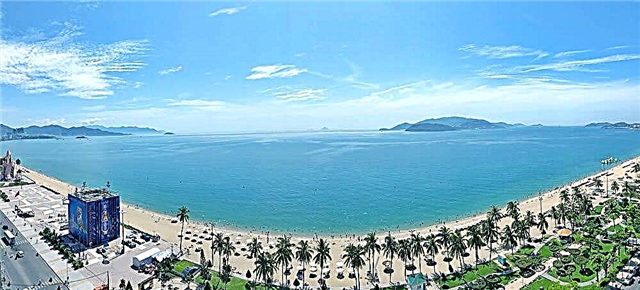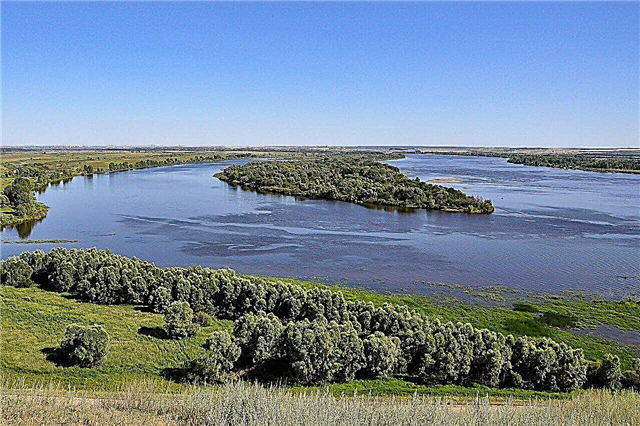There are more than 4 thousand rivers in Tatarstan. In the spring, the rivers come out of their channel, flooding the surroundings. The rivers are fed mixed. In terms of chemical composition, the rivers of Tatarstan are hydrocarbonate. But there are sulfate waters in the Predkamye, and even with chloride waters, for example, the rivers of the Ik River basin.
The valleys of large rivers have slope asymmetries. This is due to their unequal heating in the cool climate of the republic. The right south-western, steeper banks are composed of bedrocks. A large number of terraces above the floodplain are observed on gentle slopes along the left bank. River valleys are often indented with ravines.
The longest rivers of Tatarstan
List of the largest rivers flowing through the territory of the republic.
Volga
This is the largest and most abundant artery of the republic. The Volga flows into the Caspian Sea. This fact is known to everyone. But the Caspian does not belong to any ocean. Therefore, the Volga has no communication with the oceans. The Volga and its tributary Kama are the most important waterways of Tatarstan. The waters of these rivers are used to generate electricity. Boat excursions are organized along the Volga. A large number of recreation centers operate along the banks of Mother Volga. Twenty species of valuable commercial fish and crayfish are found in the Volga.
The length of the river is 3530 km, in Tatarstan - 177 km

Kama
The deepest river in Tatarstan. The source of the river consists of four streams and is located on the Verkhnekamsk Upland. It is believed that the Kama flows into the Volga. But this is a moot point. There is an opinion that the channel of the Kama River was formed earlier than the great Russian river Volga. In the river valley there is a reservoir - Nizhnekamskoe, which is a source of electrical energy for a large part of the Volga region. Concrete slopes are already collapsing on the Nizhnekamsk reservoir, built in 1978. Soil erosion takes place.
The length of the river is 1805 km, in Tatarstan - 318 km

Vyatka
The source of the river is in Udmurtia. Vyatka is a tributary of the Kama River. The Vyatka estuary is located in Tatarstan near the villages of Sokolki and Grakhan. The Vyatka River also flows through the Kirov region. Vyatka runs along a wide valley. The river slopes are gentle. There are many rifts and shallows in the Vyatka River, therefore it is safer to move along Vyatka by floating craft in big water.
The length of the river is 1314 km, in Tatarstan - 64 km

Ik
This is one of the largest rivers in Tatarstan. It flows along the borders of Bashkiria and the Republic of Tatarstan, also in the Orenburg region. It flows into the Kama along the left bank. The Ik River is under ice from November to April. Ik feeds mainly on melting snow. There are large oil fields in the river basin. Every year, an expedition led by Marsel Garipov takes place along the territory of the river and its tributaries, studying the ecological state of the rivers. Based on the work of the expedition, the book "From the silence Ik flows" was published.
The length of the river is 436 km, in Tatarstan - 198 km

Sviyaga
Sviyaga takes place not only in Tatarstan, but also in the Ulyanovsk region. The river has three sources. The width of the river ranges from 5 to 40 meters. The river flows parallel to the great Volga and flows into the Kuibyshev Reservoir. The river valley is indented with gullies, ravines, very winding. Sviyaga feeds mainly on melting snow. The river is frozen from November to April. Sviyaga is a transport highway, a source of water supply for the region. There are 12 fish species in the river.
The length of the river is 375 km, in Tatarstan - 203 km

Sheshma
In addition to Tatarstan, it also carries its waters across the Samara region. The Sheshma River has a typically asymmetric meandering valley 0.9-1.2 km wide at its source, and expanding up to 4 km closer to its mouth (Kuibyshevskoe Reservoir on the Kama River). The source of the river is located on the Bugulma-Belebey Upland. The width of the river is from 100 meters to 2 km closer to the mouth. On the way, Sheshma meets the Chistye Luga reserve. This territory belongs to the forest-steppe zone. The river is famous for its abundance of fish. Fishing here is excellent both in summer and winter.
The total length of the river is 259 km

Izh
It is formed by the confluence of two rivers: Small and Big Izha. The Izh River flows first through Udmurtia, then through Tatarstan and flows into the Kama. The banks of the river are low and very picturesque. Izh is navigable in the lower reaches. The width of the Izh River is about 60 meters. The current is slow. The river is suitable for leisurely kayaking, which will be within the power of even novice tourists. The population of the area along the banks is about 20%.
The length of the river is 237 km, in Tatarstan - 97 km

Zai
In the upper reaches, the river is called the Steppe Zai. The source of the river is located near the village of Mikhailovka. The mouth of Zaya is the Staraya Kama channel. For more than forty years, the Stepnoy Zai River has been a natural monument of regional significance in Tatarstan. Built on the river: Zainskoe reservoir. and Zainskaya SDPP, Karabash Reservoir. and the Karabash small hydroelectric power station. Oil production in large volumes is carried out in the river basin on the territory of three districts of Tatarstan.
River length - 219 km

Small Cheremshan
It flows not only through the territory of Tatarstan, but also through the Ulyanovsk region. The source of the Small Cheremshan near the village of Tatarsky Eltan. Small Cheremshan flows into Big Cheremshan on the territory of the Ulyanovsk region. Since the seventies of the XX century, the Maly Cheremshan River has been a natural monument of regional significance. The banks of the river are a blooming endless meadow. And the water is silvery. It is a river with a long history. Archaeologists find along the banks of the Cheremshan ceramics with chamotte and other artifacts from the end of the 12th century.
The length of the river is 213 km, in Tatarstan - 192 km

Xun
The source of the river is in Bashkiria. In the lower reaches, the river flows along the border of Bashkortostan and Tatarstan. The river has been a protected natural monument since 1978. It flows into the Belaya River on the territory of Bashkortostan. The width of the Xun River reaches 40 meters in places. The banks of the river are overgrown with bushes and willows. There are mixed birch and spruce forests along the river. On the banks of the river, water rats and beavers are found.
The length of the river is 209 km, in Tatarstan 74 km

Myosha
The source of the river near the village of Shepshenar. It flows into the Kamsky Bay near the village of Karaduli. The river valley is heavily indented by gullies and ravines. This area was inhabited by the Mari people. The width of the river is 30 meters - 4 km. The banks of the river are high, steep, up to 10 meters high. Mesha has 45 tributaries. Residents of the capital of Tatarstan love to relax and fish on the banks of the Mesha. Near the village of Starye Zyuri there is an old cemetery with a 16th century Muslim stone. Old legends say that these are historical places.
River length - 204 km

Kubnya
The source of the river is in Chuvashia. The river is the border between Chuvashia and Tatarstan. The Kubnya River flows into the Sviyaga on the left bank. The valley of the Kubnya River is wide, with many oxbows. The river is fed mainly by precipitation. The river flow is slow. In the middle reaches, the banks of the Kubnya are covered with forest. There are many types of fish in the river. The largest fish is catfish.
The length of the river is 176 km, in Tatarstan 116 km

Kazanka
It is a left tributary of Mother Volga. The bottom of the river is limestone, which makes the water particularly hard and unsuitable for domestic consumption. Kazanka flows into the Kuibyshev Reservoir. within the city of Kazan. In the floodplain of Kazanka there is a reserve-museum Iske-Kazan. The river is of great urban planning importance for Kazan. A project is being developed to reclaim the right bank of the river. It is planned to build a modern center of the capital on these 46 hectares.
River length - 142 km

Menzel
It flows into the Nizhnekamsk reservoir. The source of the river is located near the village of Stary Menzelyabash. Several keys are gushing out of the ground here. Two of them are equipped with small architectural forms. The spring water is famous for its purity and taste. The valley of the Menzel River is asymmetric with ravines and karst rocks. The river is shallow with snow supply. The river is used for agriculture and fishing.
River length - 123 km

Toyma
The source of the river is in Udmurtia. The Toyma flows into the Kama in the vicinity of Elabuga.The banks of the river are low, overgrown with alder and vines. The forest is at a distance of one hundred or two hundred meters from the water. The river has 35 tributaries. The bottom of the river is either sandy-silty or rocky. The Lower Kama National Park is located in the lower section of Toyma. In the park along the river Bolshoi Bor grows with a predominance of pine. There are five dams on the river. Beavers are found. Plenty of fish.
Length - 121 km, in Tatarstan - 81 km

Big Sulcha
The source is located east of the village of Amirovo. Bolshaya Sulcha flows into Bolshoi Cheremshan on the right side. The river bed is meandering. The banks of the river are clayey, in places covered with low bushes. 90% of the river is fed by snow. This is a shallow river. The depth of the Bolshaya Sulcha River does not exceed 1.5 meters. The river is used in agriculture and is a natural monument of Tatarstan.
River length - 117 km

Kichuy
The largest tributary of the Sheshma. The source of the river is located two kilometers from the village of Minnibaevo. Urganchinsky botanical reserve is located in the river valley. The village of the same name, founded in the thirties of the 18th century, is located on the river. At the same time, an earthen fortress was erected feldshanets to protect Russia from the Bashkirs, Nogai and other nomads. The walls of the fortress are shaped like a quadrangle. They are compass oriented. The taras (filling) rampart and the ditches of the fortress have survived to this day.
River length -114 km

Shoshma
The source is located near the village of Shushmabash in Tatarstan. And the mouth of Shoshma is located in the Kirov region. Shoshma flows into the Vyatka River on the right side. The river valley is cut by numerous ravines, along which streams run. The river is 20-30 meters wide. The left bank of the river is steeper than the right one. The banks of the river are plowed up for fields. The river is used in agriculture. There are places for relaxation and swimming along the banks of the river. There are oak plantations on the left bank. Beavers and muskrats live in burrows along the banks of the river.
The total length of the river is 105 km

Aktay
The source of the Aktay River is located near the village of Verkhniye Mataki. Aktai flows into the Kuibyshev reservoir. The water in the river is odorless, yellowish. In the upper reaches, the Aktai River dries up. The river is typically flat. The river bed is winding up to 7 meters wide. The bottom is sandy, silty. In the floodplain of the river, mainly meadow vegetation grows. The water of the Aktai River is used for irrigation of fields and grazing. The river attracts fishermen with bream, crucian carp, carp.
River length - 89 km

Ashit
The source of the river is located between the villages of Ashibash and New Kyrlay in Tatarstan. Before flowing into the Ilet River, the Ashit River enters the territory of the Republic of Mari El. The floodplain of the river is swampy in places. After the deforestation took place, the Ashit River basin ended up in plowed fields. Spring high water makes the river fast and attractive for water tourists. On the river there are destroyed dams, which pose some danger to boats.
The total length of the river is 89 km

Ulema
The Ulema River originates from the place where the village of Krasnye Dvoriki used to be. The river flows through the area heavily indented by ravines and ravines. The river belongs to the low-water rivers of the republic. It flows into the Sviyaga River from the right side. The waters of the river are used in agriculture. The fossilized remains of an ancient animal have been found for the first time near the river. In honor of the river, the herbivorous lizard was named Ulemosaurus.
River length - 72 km

Shia
The tributary of the Vyatka, the Shiya River, originates in the Kyzyl-Yulduz forestry enterprise. The village of Nikiforovo is located along the river. Behind it, the Subash tributary flows into the Shiya on the right. Behind the village of Ishkeevo, the Shiya river turns north. Then it flows through the village of Taveli. It receives a tributary of the Chaksa. Then a tributary of the Bash-Arbashi flows into the Shia in the village of Tulbay. Then Shia is fed by the rivers Ucha, Iskubash, Yukachi. Shiya belongs to the Kama river basin.
River length - 68 km

Malaya Sulcha
The source of the river near the village of Sulche-Bash. The estuary is located on the right side of the Bolshaya Sulcha River near the village of Karasa. Malaya Sulcha is a flat, unremarkable river. The right banks of the river are steeper than the left ones. The river bed is rather winding. The river is fed mixed. Malaya Sulcha has nine tributaries. In terms of chemical composition, the water of Malaya Sulcha is hard, and in spring it is even very hard. The river is polluted by enterprises.
River length - 67 km

Forest Zay
It flows into the Zai River. It was first mentioned in the 17th century under the name of the Irnya River. In the Almetyevsk region, along the banks of the river, one can come across oil pumps. Where the Lesnoy Zai flows, a fortified line was built behind the Kichuevsky prison in the 18th century, and a bridge existed. On the opposite bank there was a new fortification - Zainyok. A 2 km long section of the rampart near the village of Novospassk has survived to this day.
River length - 63 km

Bima
The source of the river is in the Agryz region of the Tatar republic. Most of the river is the border between Tatarstan and Udmurtia. The estuary is located in Udmurtia. Bima is a tributary of the Kyrykmas. On the left bank of the Bima River there is a village of the same name, founded in the middle of the 17th century. The inhabitants of the village (Mari) are engaged in cattle breeding, field cultivation. The village has a feldsher-midwife station, schools, kindergartens, a library, and a village club.
The total length of the river is 60 km



